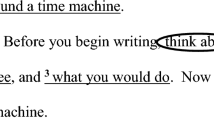Abstract
For the past eight years, Australian school students in Years 3, 5, 7 and 9 have engaged in the National Assessment Program–Literacy and Numeracy (NAPLAN) writing test, with a one-in-two chance they will be tasked with producing a ‘narrative’ genre. This paper examines the way in which the very notion of storytelling and narrative is conceptualised in the NAPLAN supporting documentation, and its potential negative consequences. The paper begins by providing a review of the literature on storytelling, paying particular attention to research which has established the ‘ComplicationResolution’ narrative as one type of storytelling. It then provides an account of how story and narrative are typically characterised and defined in the official NAPLAN documentation, that is, as the ‘Complication-Resolution’ narrative exclusively. The final section of the paper presents a genre analysis of eight student writing samples and the related comments and gradings from the NAPLAN narrative marking guide. The analysis found a number of student texts in the marking guide that were effectively structured stories, but which had been marked down for Text Structure because they did not comply with the specific structure of the ‘Complication-Resolution’ narrative. The analysis also found a number of texts that scored highly with respect to the Text Structure criterion, even though they were not instances of the Complication-Resolution narrative sub-type. Drawing on these findings, the paper argues that various inconsistencies and points of apparent confusion in these comments and gradings can be taken as evidence that other sub-types of storytelling are being inappropriately devalued, and that ultimately, there is a lack of understanding in the nature of storytelling in the NAPLAN documentation. By way of conclusion, the paper reflects on some of the negative consequences that may flow from storytelling being defined in this limited way, including the implications for how storytelling is taught by teachers and caregivers, the potential misdirection of students as to what constitutes a ‘good’ story, as well as the cultural implications of limiting stories to one specific type.
Similar content being viewed by others
References
Angelo, D. (2011). Sad stories: a preliminary study of NAPLAN practice texts analysing students’ second language linguistic resources and the effects of these on their written narratives. Proceedings of the 42nd Australian Linguistic Society Conference. Canberra
Angelo, D. (2013). NAPLAN implementation: implications for classroom learning and teaching, with recommendations for improvement. TESOL in Context, 23 (1/2), 53–73.
Australian Curriculum Assessment and Reporting Authority (ACARA) (2010). National Assessment Program–Literacy and Numeracy 2010: Writing narrative marking guide. Retrieved from http://www.nap.edu.au/verve/_resources/2010_Marking_Guide.pdf
Australian Curriculum Assessment and Reporting Authority (ACARA) (2013). NAP: Writing. Retrieved from http://www.nap.edu.au/naplan/writing/writing.html
Exley, B. (2010). Narratives for novices: is there a place for edgy texts in edgy NAPLAN communities? Practically Primary, 15 (3), 4–7.
Exley, B. & Mills, K. (2015). Interrogating policy contradictions in literacy reforms about persuasive texts. Paper presented at AERA 2015 Annual Meeting: Toward Justice: Culture, Language, and Heritage in Education Research and Praxis, Chicago, Illinois, 16–20 April 2015.
Gable, A. & Lingard, B. (2013). NAPLAN and the performance regime in Australian schooling: A review of the policy context. St Lucia, QLD, Australia: The University of Queensland, School of Social Work and Human Services, Social Policy Unit.
Gee, J.P. (2005). An introduction to discourse analysis. London: Routledge.
Jordens, C.F.C, (2002). Reading spoken stories for values: A discursive study of cancer survivors and their professional carers. Unpublished PhD thesis. University of Sydney.
Literacy Educators Coalition (2015). Literacy Educators Coalition: Say no to NAPLAN. Retrieved from http://www.literacyeducators.com.au/naplan/naplan-articles/
Labov, W. & Waletzky, J. (1967). Narrative analysis: Oral versions of personal experience. In J. Helm (Ed.), Essays on the Verbal and Visual Arts (pp. 12–44). Seattle: University of Washington Press.
Literacy Educators Coalition (2015). Literacy Educators Coalition: Say no to NAPLAN. Retrieved from http://www.literacyeducators.com.au/naplan/naplan-articles/
Love, K. & Humphrey, S. (2012). A multi-level language toolkit for the Australian Curriculum: English. Australian Journal of Language and Literacy, 35 (1), 169–191.
Martin, J.R. & Rose, D. (2008). Genre relations: Mapping culture. London: Equinox.
Martin, J.R & Rose, D. (2011). Encounters with genre: Apprehending cultural frontiers. In B. Baker, I. Mushin, M. Harvey & R. Gardner (Eds.), Indigenous Language and Social Identity: Papers in Honour of Michael Walsh (pp. 333–346). Canberra, ACT: Pacific Linguistics.
Martin, J.R & White, PRR. (2005). The language of evaluation: Appraisal in English. New York: Palgrave MacMillan.
Mills, K. & Dooley, K. (2014). Teaching persuasive texts: building a language of evaluation through hedging and moderated intensification. Literacy Learning: the Middle Years, 22 (3), 33–41.
O’Neil, S. (2012). Teaching and assessment of persuasive writing: juggling the language features and grasping the metalanguage. International Journal of Pedagogies and Learning, 7 (1), 84–98.
Plum, G. (1988). Text and contextual conditioning in spoken English: A genre-based approach. Unpublished PhD thesis. University of Sydney.
Ryan, M.E. & Barton, G. (2013). Working towards a ‘thirdspace’ in the teaching of writing to middle years students. Literacy Learning: The Middle Years, 21 (3), 71–81.
Thomas, D., Thomas, A. & Moltow, D.T. (under review). Evaluative stance in high achieving year 3 persuasive texts. Linguistics and Education.
Thompson, G. & Cook, I. (2012). Manipulating the data: teaching and NAPLAN in the control society. Discourse: Studies in the Cultural Politics of Education, 35 (1), 129–142.
Thompson, G. & Harbaugh, A.G. (2013). A preliminary analysis of teacher perceptions of the effects of NAPLAN on pedagogy and curriculum. Australian Educational Researcher, 40 (3), 299–314.
White, P.R.R. & Makki, M., in press, Crime reporting as storytelling in Persian/Farsi news journalism–perspectives on the narrative function. Journal of World Languages.
White, P.R.R., Mammone, G. & Caldwell, D. (2015). Linguistically based inequality, multilingual education and a genre-based literacy development pedagogy: insights from the Australian experience. Language and Education, 29 (3), 256–271.
Author information
Authors and Affiliations
Rights and permissions
About this article
Cite this article
Caldwell, D., White, P.R.R. That’s not a narrative; this is a narrative: NAPLAN and pedagogies of storytelling. AJLL 40, 16–27 (2017). https://doi.org/10.1007/BF03651981
Published:
Issue Date:
DOI: https://doi.org/10.1007/BF03651981




